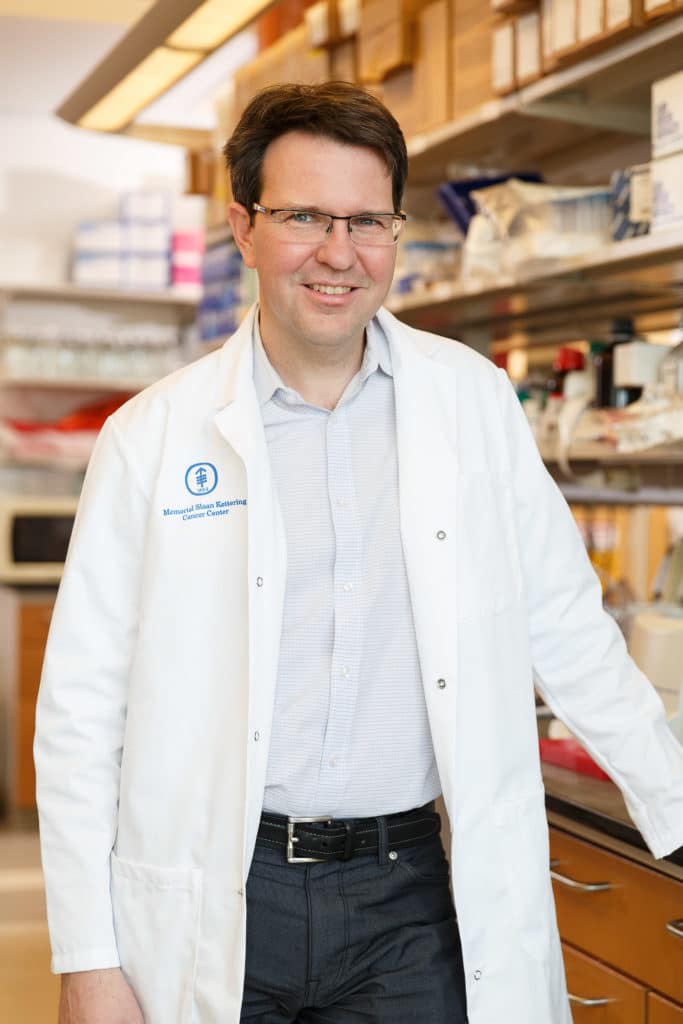
Hans-Guido Wendel, MD (Memorial Sloan Kettering Cancer Center) is a two-time recipient of the Lymphoma Research Foundation’s Follicular Pathways Grant, and a member of LRF’s Scientific Advisory Board. As befits the grant name, Dr. Wendel’s research focuses on the microbiology of lymphoma cells, identifying proteins within our tumor cells that represent crucial functions for cell growth, or allow a malignant cell to avoid destruction by the immune system. These biomarkers and pathways, once identified, offer avenues along which new therapies can be developed.
In October 2016, Dr. Wendel and his colleagues published a paper in the academic journal Cell, in which they posited a new potential use for chemeric antigen receptor (CAR) T-cell therapy, one which may open a number of new possibilities for this type of immunotherapy in general and for lymphoma patients in particular. The following is a brief interview with Dr. Wendel on his research and its implications for lymphoma patients.
How does your work in CAR T-cells, as published in Cell, differ from current research using CD 19 CAR T-cells?
CAR T-cells have entered the clinic and they work by targeting cells that express the CD19 receptor. These include lymphoma and acute lymphoblastic leukemia (ALL) cells and also normal B lymphocytes. The treatment is highly effective against B-ALL and less so against lymphoma.
We set out to improve the activity against lymphoma. We found that a cell surface receptor HVEM/TNFRSF14 is inactivated by mutations or deletions of the whole gene in some 50 percent of human lymphomas. We further found that this receptor normally binds to another receptor called BTLA (T and T Lymphocyte Attenuator) and represses lymphocyte growth. Hence, lymphoma cells need to inactivate this interaction.
We reasoned that delivering the HVEM receptor protein should re-engage this growth repressive mechanism. The next question then is: How do we deliver HVEM specifically to lymphoma cells? We reasoned that we could use CAR T-cells that seek out lymphomas to deliver the HVEM protein. Hence, we turned the CAR T-cell into a ‘micro-pharmacy’ that contains an anti-tumor protein [which delivers to malignant lymphoma cells].
How is your lab planning to further develop or build on this research?
We are pursuing two directions: 1) Develop CART/HVEM cells towards clinical application. 2) We realize that the use of CAR T-cells as delivery vehicles is more broadly useful and we are pursuing other “payloads” – other cancer suppressive factors that could be added to CAR T-cells to inhibit specific cancers.
This is a new strategy aimed at increasing the effectiveness of CAR T-cell therapy. We hope to bring this procedure to the clinic, but it will take a couple of years before we are ready to do so. Most likely this approach will be used in pre-treated patients whose disease has recurred.
Your lab specializes in translation and basic discovery research. Can you explain how these types of research impact the clinical trials that most lay people think of when they think of medical research?
My lab is not involved in clinical trials or accompanying analyses. We try to envision completely new strategies for future therapies. These may be a long way from clinical use and some may never make it there. However, our goal is to invent and begin to explore future therapies.
You have received multiple LRF grants through the Follicular Lymphoma Pathways program. How have those grants aided your research (either this research specifically, or in general)?
Our research is “high-risk and high-gain” and conventional funding agencies (such as the National Institutes of Health) tend to be very conservative and less likely to support innovative and risky studies such as the use of T-cells as cellular pharmacies. We are excited that LRF is supporting our studies, which is absolutely essential to push new ideas like this from the lab towards the clinic.